Mudra in a supporting role: How to use mudras to help manifest the intention of your practice
2Last week we discussed how you can organize an entire practice around a mudra, if you give your mudra a leading role in your yoga practice. A mudra can also play a supportive role to help unfold the theme of the practice and support some other main element of your choice (remember, in more complex practices it is better to have just one dominant element). A well-selected mudra can help manifest your intention for the practice on the physical, energetic or mental level.
Physical level
When you work with the body on the physical level, asana usually becomes the primary element of the practice with other elements playing supporting roles. When you choose to work with physical aches and pains, like back or neck pain, hip tension and the like, you can always complete your practice with a mudra that specifically addresses that ailment. Back Mudra, for example, is meant to relieve tension in your lower back, or Maha Sacral mudra is supposed to help with pain in the lower abdomen.
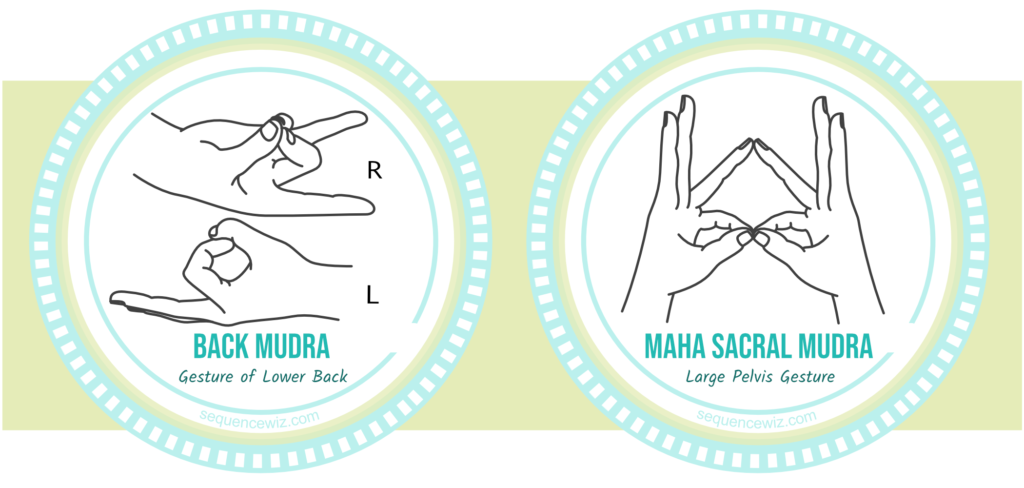
Many mudras don’t target individual body parts directly but can still be very useful in working with the physical dimension indirectly. For example, there is no mudra (that I know of) specifically for your hip flexors. 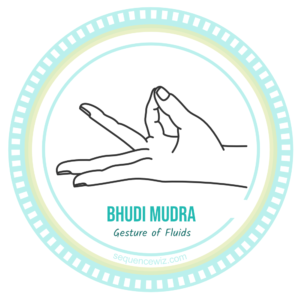 But you can design an entire practice around releasing tension in your hip flexors and then during meditation instruct your students to imagine that their pelvic bowl is full of water (to facilitate the sense of muscular pliability and nourishment). You can hold Bhudi mudra (Gesture of Fluids) during meditation to enhance that sense of fluidity and pliability. Or, instead of looking for a specific mudra for upper back tension, for example, you might use Garuda (Eagle) mudra during meditation and imagine spreading your wings and expanding your upper back. In fact, most mudras have symbolic, rather than literal, names and meanings, and we can evoke that symbolism in different ways to support our intention for the practice.
But you can design an entire practice around releasing tension in your hip flexors and then during meditation instruct your students to imagine that their pelvic bowl is full of water (to facilitate the sense of muscular pliability and nourishment). You can hold Bhudi mudra (Gesture of Fluids) during meditation to enhance that sense of fluidity and pliability. Or, instead of looking for a specific mudra for upper back tension, for example, you might use Garuda (Eagle) mudra during meditation and imagine spreading your wings and expanding your upper back. In fact, most mudras have symbolic, rather than literal, names and meanings, and we can evoke that symbolism in different ways to support our intention for the practice.
Physiological/ Energetic level
When you are working with the energetic or physiological dimension, breath awareness and/or pranayama usually become the dominant element(s). There are many mudras that address particular physiological issues (like circulatory, digestive and breathing challenges, headaches, allergies and so on). There are even more mudras that work with our subtle energetic anatomy (vayus, chakras, nadis, elements, and so on). Here we are trying to affect our energetic currents that are supposed to move in certain directions, be located in specific parts of the body, and perform certain functions. If we choose to work with energy mudras, it is important that we select yoga poses and breathing practices that do not contradict the energetic current of the mudra. For example, if you spend an entire practice on expanding the chest and focusing on the heart chakra and then at the end add a mudra that guides Apana Vayu, which resides in the lower abdomen and moves the energy down and out, this might feel confusing to your students.
I also find that many mudras have rather pronounced energetic qualities and, even if they seem like they might fit with the theme of my practice in name, they might not fit well energetically. 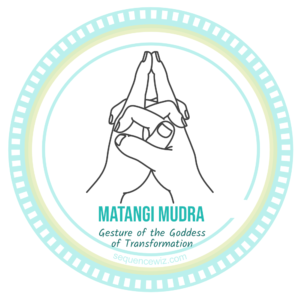 For example, let’s say I design a practice that is meant to aid digestion by the action of gentle hugging of the abdomen. I could try to end the practice with Matangi Mudra which is meant to activate Samana Vayu and help with digestion and assimilation. But when I try it myself, the gesture and the feeling it gives me doesn’t seem to align with my intention. The practice is calling for a gentle cradling of the abdomen or some other comforting gesture. That is why it is so important to experiment with different mudras yourself first before you teach them to your students to get a sense of their energetic qualities.
For example, let’s say I design a practice that is meant to aid digestion by the action of gentle hugging of the abdomen. I could try to end the practice with Matangi Mudra which is meant to activate Samana Vayu and help with digestion and assimilation. But when I try it myself, the gesture and the feeling it gives me doesn’t seem to align with my intention. The practice is calling for a gentle cradling of the abdomen or some other comforting gesture. That is why it is so important to experiment with different mudras yourself first before you teach them to your students to get a sense of their energetic qualities.
Mental/psychological level
When we design a yoga practice that is meant to affect one’s state of mind, we usually choose chanting or meditation as the dominant element. Mudras can work really well to deepen the main topic of meditation and promote a particular state of mind. The key here, again, is not to send mixed messages and not to confuse our metaphors. If you are trying to help your students feel more grounded, it makes more sense to use Earth mudra rather than Wind mudra, 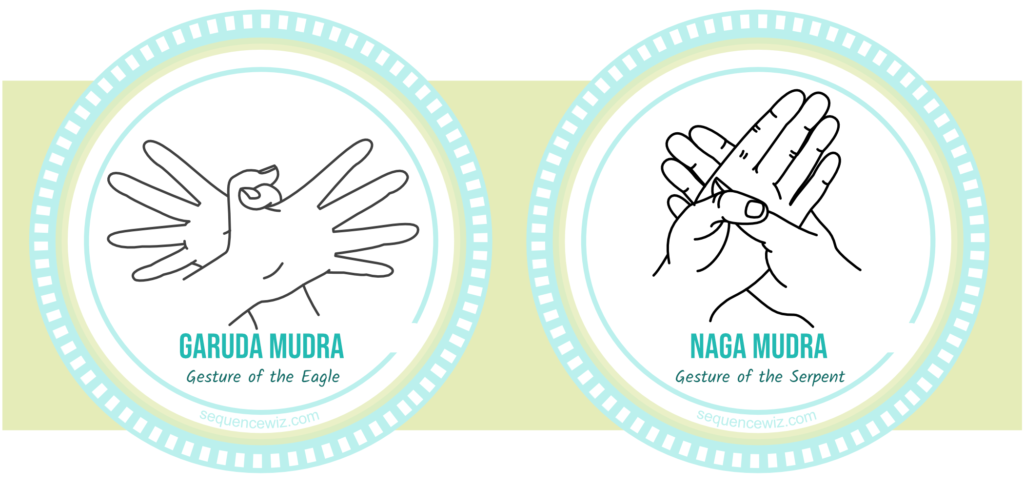 and if you spend the entire practice encouraging them to soar like an Eagle, it might make more sense to do Garuda mudra than Naga Mudra, which is a tribute to a Snake goddess. There is also a group of mudras known collectively as spiritual mudras that can work well with most meditation themes. Jnana mudra, Anjali mudra, Dhyana mudra and others, promote the state of contemplation, centering and inner focus. They can support most mental state you wish to cultivate.
and if you spend the entire practice encouraging them to soar like an Eagle, it might make more sense to do Garuda mudra than Naga Mudra, which is a tribute to a Snake goddess. There is also a group of mudras known collectively as spiritual mudras that can work well with most meditation themes. Jnana mudra, Anjali mudra, Dhyana mudra and others, promote the state of contemplation, centering and inner focus. They can support most mental state you wish to cultivate.

In the traditional yogic approach, we use asana to prepare for pranayama, and pranayama to prepare for meditation. That is why we usually do yoga poses first, then do seated breathing practices and then do seated meditation (there are exceptions, of course). It makes the most sense to do our mudras during meditation to optimize their effect, although we can also do some of them during Savasana. There are also times when we can do mudras throughout the practice. For example, we can use Anjali mudra at different points of the practice to punctuate it with points of stillness and internal focus to pay attention to how the body responds to different parts of the practice.
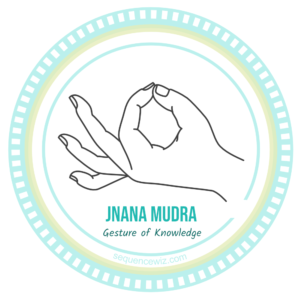 I’ve also been to practices where teachers included mudras with asana. For example, in one class we were invited to hold Jnana mudra with one hand during Dancer pose. Adding Jnana mudra in the Dancer pose won’t hurt anything, but the question is – what is the intention here? Dancer pose is already challenging enough for many students, it requires serious concentration to hold that pose. If you add a mudra to it, the question arises – where should your attention go? Should you focus on the action of balancing, on the action of back bending or on the mudra? If your attention keeps fluctuating between those points, it makes it harder to stay balanced and focused.
I’ve also been to practices where teachers included mudras with asana. For example, in one class we were invited to hold Jnana mudra with one hand during Dancer pose. Adding Jnana mudra in the Dancer pose won’t hurt anything, but the question is – what is the intention here? Dancer pose is already challenging enough for many students, it requires serious concentration to hold that pose. If you add a mudra to it, the question arises – where should your attention go? Should you focus on the action of balancing, on the action of back bending or on the mudra? If your attention keeps fluctuating between those points, it makes it harder to stay balanced and focused.
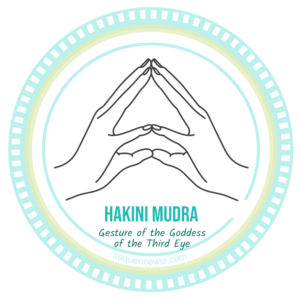 On the other hand, it can be really beneficial to use Haikini mudra in Tree pose, for example. Haikini mudra helps with concentration and improves coordination between the right and left brain hemispheres. Holding this mudra in Tree pose and gently pressing the fingers of your hands into each other can serve as a centering point and can actually help you balance in the pose. This is an example of mudra supporting the intention of the pose. Whenever you decide whether or not to add mudras to yoga poses, the main question is always the same – would the mudra support or hinder the intention behind the pose?
On the other hand, it can be really beneficial to use Haikini mudra in Tree pose, for example. Haikini mudra helps with concentration and improves coordination between the right and left brain hemispheres. Holding this mudra in Tree pose and gently pressing the fingers of your hands into each other can serve as a centering point and can actually help you balance in the pose. This is an example of mudra supporting the intention of the pose. Whenever you decide whether or not to add mudras to yoga poses, the main question is always the same – would the mudra support or hinder the intention behind the pose?
In addition, there is a whole separate category of ritualistic hand gestures that work really well with yoga poses. They are called nyasas and we will talk about them next time – tune in!
[jetpack_subscription_form]
All of the mudras featured in this post (and many more) are included in Sequence Wiz yoga sequence builder. You can easily add them to your sequences. Learn more about yoga sequence builder >


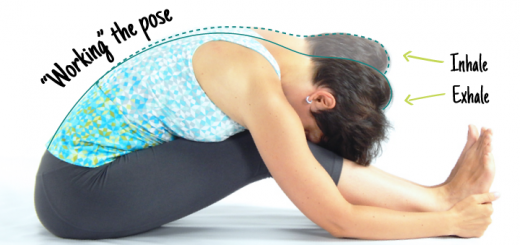
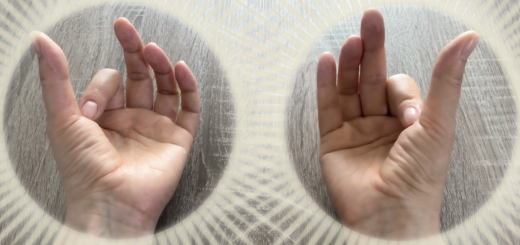
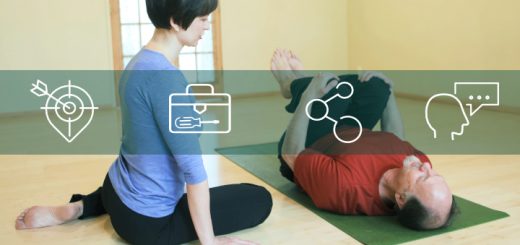
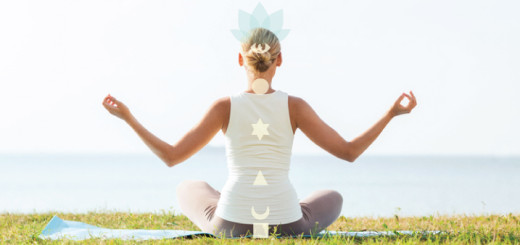















Hi Olga
Very beautifully explained now it make sense to mudras
Now I’m curious to know about ascending energy and descending energy?
And also unilateral nostril breathing benefits
And nostril dominance ( ie every 2 hour nostril keep switching meaning at what time left nostril breathing starts ? What time right nostril starts
So many questions arises in my mind
I hopped you’d explain all these in your next topic
Thanks
Manju
Olga, I think I may have unsubscribed from your blog in the past – I just resubscribed! Thank you for this thoughtful post. I enjoy using mudras when teaching, and I think your insights will help me to do so in an even more mindful manner. Thank you again!